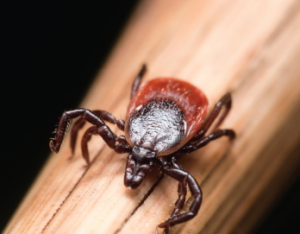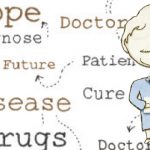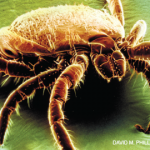
A bite from an infected tick can lead to symptoms of Lyme disease within one to four weeks.
Steven Ellingson/shutterstock.com
CHICAGO—A clustering of cases in Lyme, Conn., in 1975 led to the discovery of Lyme disease. Allen C. Steere, MD, professor of medicine at Harvard Medical School in Boston, investigated that outbreak, and he shared his knowledge of Lyme disease with rheumatologists gathered at the ACR’s State-of-the-Art Clinical Symposium in April. He explained that Lyme arthritis was recognized as a separate disease because of the clustering of the children in Lyme, and since that time, the number of cases of Lyme disease in the U.S. has increased significantly.
Absent antibiotic treatment, Lyme disease unfolds in stages. When the infection begins, it is typically localized to the skin where it causes a slowly expanding skin lesion, often associated with such symptoms as neck stiffness, headache and arthralgias. Stage two follows weeks to months after infection and patients can experience Lyme neuroborreliosis, which presents as acute neurologic involvement, lymphocytic meningitis, cranial neuritis and/or sensory or motor radiculopathy. Patients may also experience Lyme carditis with atrioventricular block. The late stage of Lyme disease happens months to years after disease onset. The most common manifestation of late disease is Lyme arthritis, which presents in one or a few joints, most commonly the knee. Typically, patients in this stage do not have systemic symptoms. Late Lyme neuroborreliosis may also rarely occur in late-stage Lyme disease, and it is characterized by subtle encephalopathy or sensory polyneuropathy.
Diagnosis
Diagnosis of Lyme disease requires a combination of characteristic clinical signs and symptoms and known exposure to an endemic area. Physicians can use serological tests to confirm infection, and the results are interpreted according to the criteria of the Centers for Disease Control and Prevention and the Association of State and Territorial Public Health Laboratory Directors. During the first 30 days of symptoms, at least two of three IgM bands are required for a positive test result. At any time of illness, at least five of 10 IgG bands are required. Dr. Steere emphasized that “there can be false-positive IgM responses,” but the IgG criteria have high specificity.
Most patients do not test seropositive during the first several weeks of infection, but by convalescence, these patients often seroconvert. By late infection, virtually every patient is IgG seropositive. After appropriate antibiotic treatment, the amount of specific antibody declines, but the Western blot, a nonquantitative test, does not change much. This does not mean that they are still infected.
At any time of illness, at least five of 10 IgG bands are required [for diagnosis of Lyme]. Dr. Steere emphasized that ‘there can be false-positive IgM responses,’ but the IgG criteria have high specificity.
Treatment
“Treatment of Lyme disease is often straightforward,” explained Dr. Steere, “but arthritis may be harder than that.” Thus, rheumatologists should treat Lyme arthritis with an algorithm, beginning with doxycycline therapy. Dr. Steere explained that although doxycycline usually works, there are patients in whom the arthritis does not change much after 30 days of treatment with oral antibiotic therapy. Some of these patients then respond to IV antibiotic therapy. Ceftriaxone is most commonly used for that purpose.
Other patients develop proliferative synovitis despite oral and intravenous antibiotic therapy, called postinfectious, antibiotic-refractory Lyme arthritis. Dr. Steere concluded that, “We do not think this is due to an active infection.” This assessment is reinforced by the fact that when these patients are treated with immunosuppressive medications, such as methotrexate or tumor necrosis factor (TNF) inhibitors, their infection does not reactivate.
Autoimmune Disease
Dr. Steere explained that antibiotic-refractory Lyme arthritis is likely caused by excessive inflammation from a combination of certain spirochetal factors and specific host factors. He specifically mentioned RST1 strains of the spirochete as a particularly inflammatory subtype. The combination of infection with this subtype and certain host genetic factors cause excessive inflammation, which paves the way for pathology. Specifically, these patients exhibit marked stimulation of pro-inflammatory pathways that result in excessively high levels of interferon (IFN)-ɣ, with inadequate levels of IL-10.
This phenomenon happens more often in individuals with a certain toll-like receptor (TLR)-1 polymorphism that is common in the European Caucasian population and/or in individuals with immune dysregulation of the CD4+ effector T cell/regulatory T cell ratio. People with this predisposition can go on to develop pathogenic autoimmunity from infection with B. burgdorferi. For example, some of these patients develop T and B cell responses to endothelial cell growth factor (ECGF), and ECGF autoantibody levels correlate strongly with the magnitude of obliterative microvascular lesions in synovial tissue.
Finally, systemic autoimmune joint diseases, such as rheumatoid arthritis, may follow Lyme disease. This complication most commonly follows antibiotic-treated erythema migrans. Compared with patients with antibiotic-refractory Lyme arthritis, these patients generally have polyarthritis and low-titer B. burgdorferi antibodies, whereas Lyme arthritis is associated with monoarticular or oligoarticular joint involvement and high-titer B. burgdorferi antibodies. These factors may provide insights for correct diagnosis.
Lara C. Pullen, PhD, is a medical writer based in the Chicago area.


